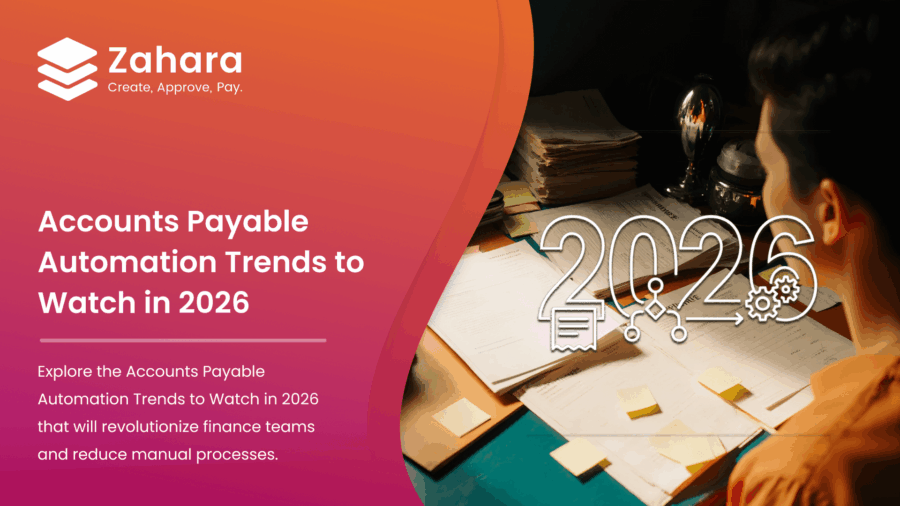Key Takeaways
- Accounts Payable Automation Trends in 2026 focus on AI-driven processing, leading to faster invoice capture and fewer errors.
- Embedding payments within automation systems enhances visibility and allows teams to approve payments in one place.
- Self-service portals for suppliers improve communication and reduce back-and-forth, fostering stronger relationships.
- Low-code tools simplify integration and allow finance teams to create workflows without needing developers.
- These trends ultimately lead to increased efficiency, better cash control, and a smoother month-end process.
Accounts payable automation is moving fast. Finance teams are upgrading their systems because manual invoice handling wastes time, adds mistakes, and slows down month-end.
2026 will bring new tools, smarter workflows, and better controls.
Table of Contents
This guide explains the key accounts payable automation trends for 2026 and how they will change the way finance teams work. It also shows how tools like Zahara help teams stay ahead.
What Accounts Payable Automation Means in 2026
Accounts payable automation refers to software that handles invoice capture, coding, routing, approval, and payment without manual work.
By 2026, this process is more intelligent than ever.
Teams expect:
- faster invoice capture
- fewer errors
- better reporting
- strong audit trails
- connected data across POs, invoices, and payments
Modern tools also reduce admin, cut month-end pressure, and speed up payment cycles.
For more detail on the software itself, see Accounts Payable automation software.
Why 2026 Will Be a Breakthrough Year for Accounts Payable Automation
Finance teams face pressure to close the books faster.
Suppliers want real-time updates.
Leaders want better cash flow visibility.
Regulation around payments and reporting is getting tighter.
2026 creates a perfect moment for change.
Teams want tools that help them:
- avoid mistakes
- reduce fraud risk
- keep documents organised
- run approvals without delay
- work from anywhere
- view spending in real-time
These expectations shape the biggest trends for 2026.
Trend 1 — AI-Driven Invoice Processing Becomes the Default
AI now sits at the heart of accounts payable automation.
It handles documents with more accuracy than older OCR systems.
Smarter OCR and document understanding
AI reads invoices in their natural layout.
It identifies suppliers, lines, totals, and dates automatically.
It understands context, not just text.
For details on OCR, see:
Autonomous coding and matching
Systems match POs, GRNs, and invoices.
They spot common errors:
- duplicate invoices
- incorrect totals
- mismatched purchase orders
- missing data
Most invoices in 2026 need no manual coding.
Why it matters for 2026
- fewer questions for suppliers
- faster invoice approvals
- fewer mistakes
- better visibility
- more predictable month-end cycles
Teams spend less time reading PDFs and more time improving processes.
Trend 2 — Embedded Payments and Automated Supplier Payouts
Payments are moving inside AP automation systems.
Teams no longer switch between bank portals, spreadsheets, and ERPs.
Push toward centralised payment runs
Companies want a single place to approve and release payments.
They want full transparency over who was paid, when, and why.
See scheduled supplier payments for more detail.
Real-time payment visibility
Finance leaders can see:
- which payments are pending
- which are approved
- which are blocked
- which are urgent
No more guessing.
No more chasing.
AP teams shift to analysis, not admin
With payments automated, the team focuses on cash flow, risk, and supplier management.
Trend 3 — Multi-Step Approvals Get Simpler and More Intelligent
Approval workflows often slow down accounts payable.
2026 tools remove these delays.
Contextual routing powered by AI
Approvals adapt to:
- invoice value
- department
- budget holder
- supplier behaviour
- spending patterns
The system selects the right route automatically.
This reduces errors and speeds up sign-off.
Mobile-first approvals
Teams are not tied to desks.
Approvers can sign off invoices from phones or tablets.
This shortens the end-to-end cycle.
Clear auditability for finance controls
Every change gets logged.
Every approval step is recorded.
See invoice approval software for more detail.
Trend 4 — Predictive Cash Flow and Spend Forecasting
2026 AP automation platforms use AI to predict future spending.
This helps leaders prepare for:
- supplier payment spikes
- seasonal trends
- contract renewals
- risks around cash flow
Using AP data to make decisions
The software learns from historical spending.
It provides insights that support budgeting and forecasting.
Month-end becomes continuous instead of stressful
With better visibility, teams avoid the traditional “month-end rush.”
Data is clean throughout the month.
Finance leaders get accurate reports without last-minute pressure.
This fits neatly with your Construction campaign message about month-end struggles.
Trend 5 — Supplier Experience and Self-Service Portals Increase Adoption
Suppliers expect clarity.
They want to know when invoices will be paid.
They want to upload documents without back-and-forth emails.
Reduced supplier queries
Self-service portals let suppliers:
- upload invoices
- check payment status
- update details
- track progress
This lowers inbox noise for AP teams.
Better communication and fewer delays
If a supplier has an issue, they can raise it inside the portal.
This avoids long email threads.
Why this trend matters in 2026
Companies want strong supplier relationships.
Automation supports this by keeping communication consistent and clear.
Trend 6 — Compliance, Fraud Prevention, and Stronger Controls
With more digital invoices, fraud risk increases.
2026 tools help reduce it.
Automated audit trails
Every action is recorded.
This builds trust and supports compliance with internal controls.
Duplicate invoice detection and anomaly spotting
AI highlights unusual behaviour:
- new bank details
- unusual invoice value
- repeated supplier names
- fake invoices
These alerts protect the business.
Segregation of duties
Approvals follow strict rules.
The right people sign off the right invoices.
This lowers risk and improves governance.

Martin Peirce
Founder and CEO
Trend 7 — Low-Code and No-Code AP Automation
Integration used to require developers.
In 2026, low-code tools let teams build workflows themselves.
Faster onboarding
Teams can design rules, validation steps, and routes through simple on-screen tools.
Easier integrations with accounting and ERP systems
Finance systems like Business Central, Xero, QuickBooks, and Sage connect more easily.
This supports your existing Dynamics 365 automation content and aligns well with invoice automation discussions.
Trend 8 — AP Automation Moves Toward Full Procure-to-Pay Visibility
Businesses want one joined-up view of:
- purchase orders
- receipts
- invoices
- payments
AP automation sits at the centre of this change.
Joined-up PO, invoices, and payments
This creates a full audit trail.
It also removes the gaps that cause disputes and delays.
Useful internal pages here:
Unified reporting across POs and invoices
Leaders see where money is committed before it leaves the business.
This avoids surprise costs and supports spending decisions.
What These 2026 AP Automation Trends Mean for Your Finance Team
These trends show a clear direction.
Teams want better visibility, predictable workloads, and fewer manual tasks.
The main benefits include:
- faster invoice handling
- fewer disputes
- stronger supplier relationships
- better cash control
- consistent approvals
- reduced risk
- quicker month-end
- clearer insight into spending
AP automation in 2026 is not just about saving time.
It helps finance teams work with more confidence.
How Zahara Supports These 2026 Accounts Payable Automation Trends
Zahara aligns well with the trends shaping 2026.
It gives teams the tools to improve speed, accuracy, and control.
Here is a quick breakdown:
- AI-powered invoice capture
- automation for coding and matching
- clear multi-step approvals
- smart routing
- payment runs inside one system
- purchase order handling
- three-way matching
- full audit trails
- duplicate detection
- simple mobile approvals
- multi-entity support
- integrations with leading finance systems
Useful links:
- Zahara AP Automation features
- Accounts Payable automation software
- AP automation cost
- invoice processing software
FAQs About Accounts Payable Automation in 2026
What is accounts payable automation?
It is software that captures, routes, approves, and pays invoices without manual work.
It reduces errors and speeds up financial processes.
How does AP automation reduce month-end workload?
It keeps invoices up to date throughout the month.
Data stays clean, so reporting is easier and faster.
What features should a business look for in 2026?
Key features include:
- AI-driven capture
- strong approval workflows
- payment automation
- three-way matching
- fraud alerts
- supplier portals
- clear reporting
How does AP automation connect with existing ERPs?
Modern tools use low-code integrations.
They sync suppliers, POs, invoices, and payments with common systems.
What is the cost of accounts payable automation?
Prices vary by volume and features.
See the AP automation cost page for detailed information.
Start Reducing Manual Work Today
If your team wants faster approvals, cleaner month-end cycles, and stronger controls, Zahara can help.
You can book a demo or start a free trial and see how accounts payable automation works in practice.



